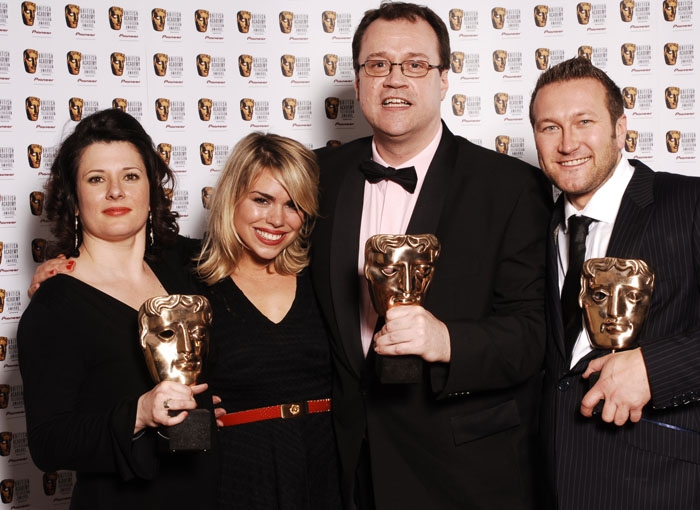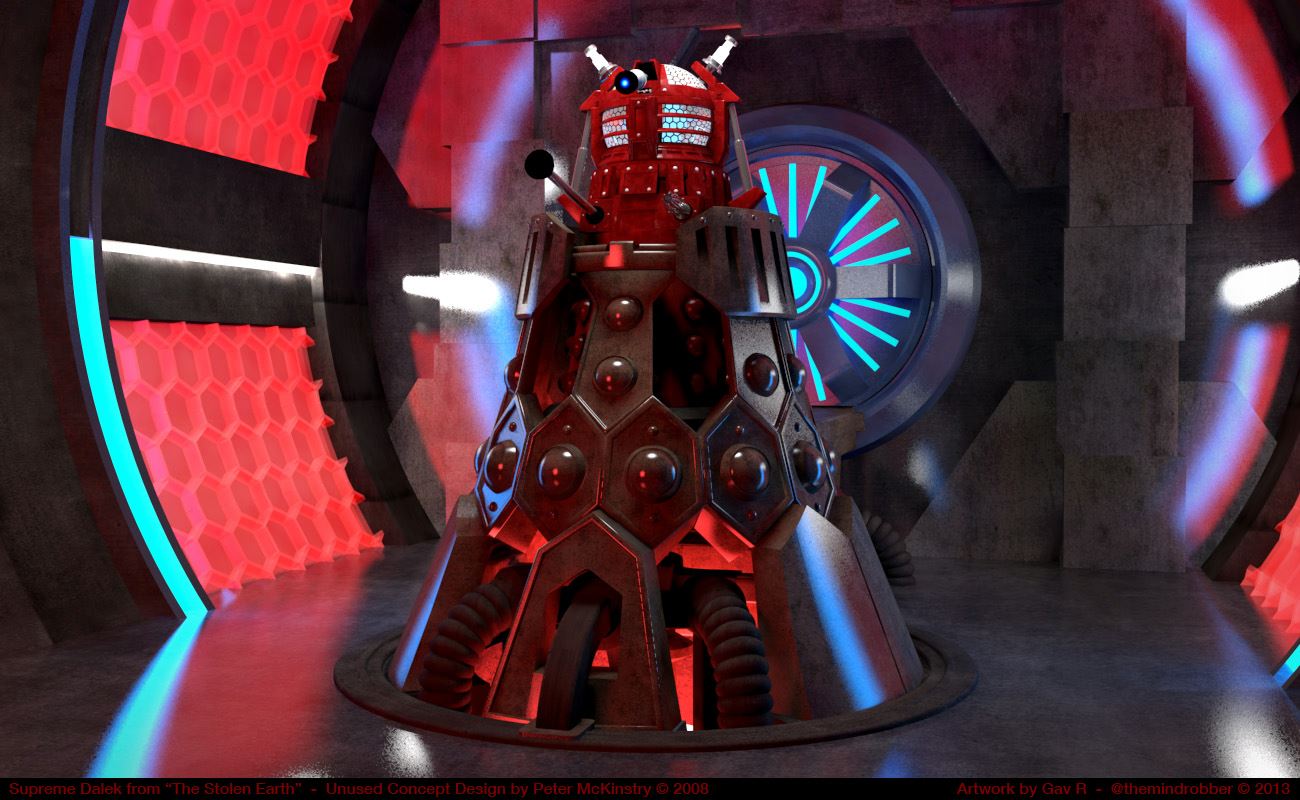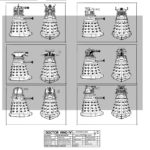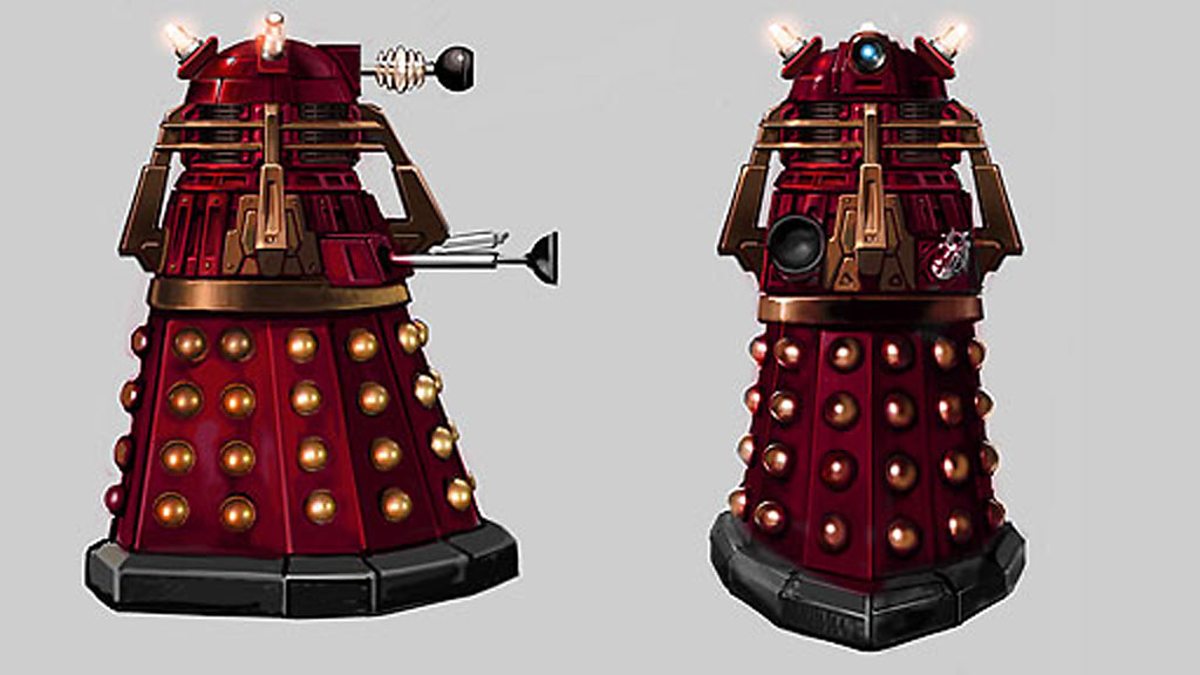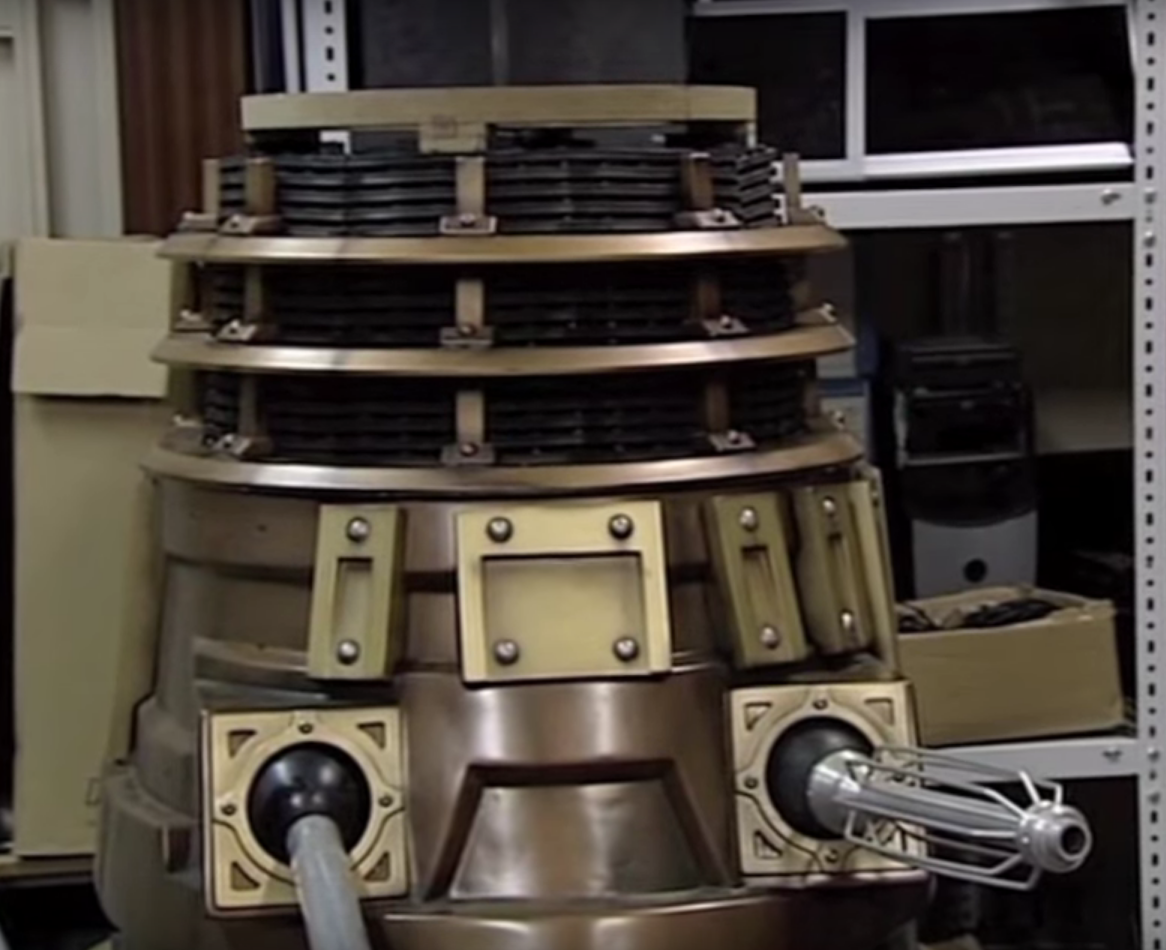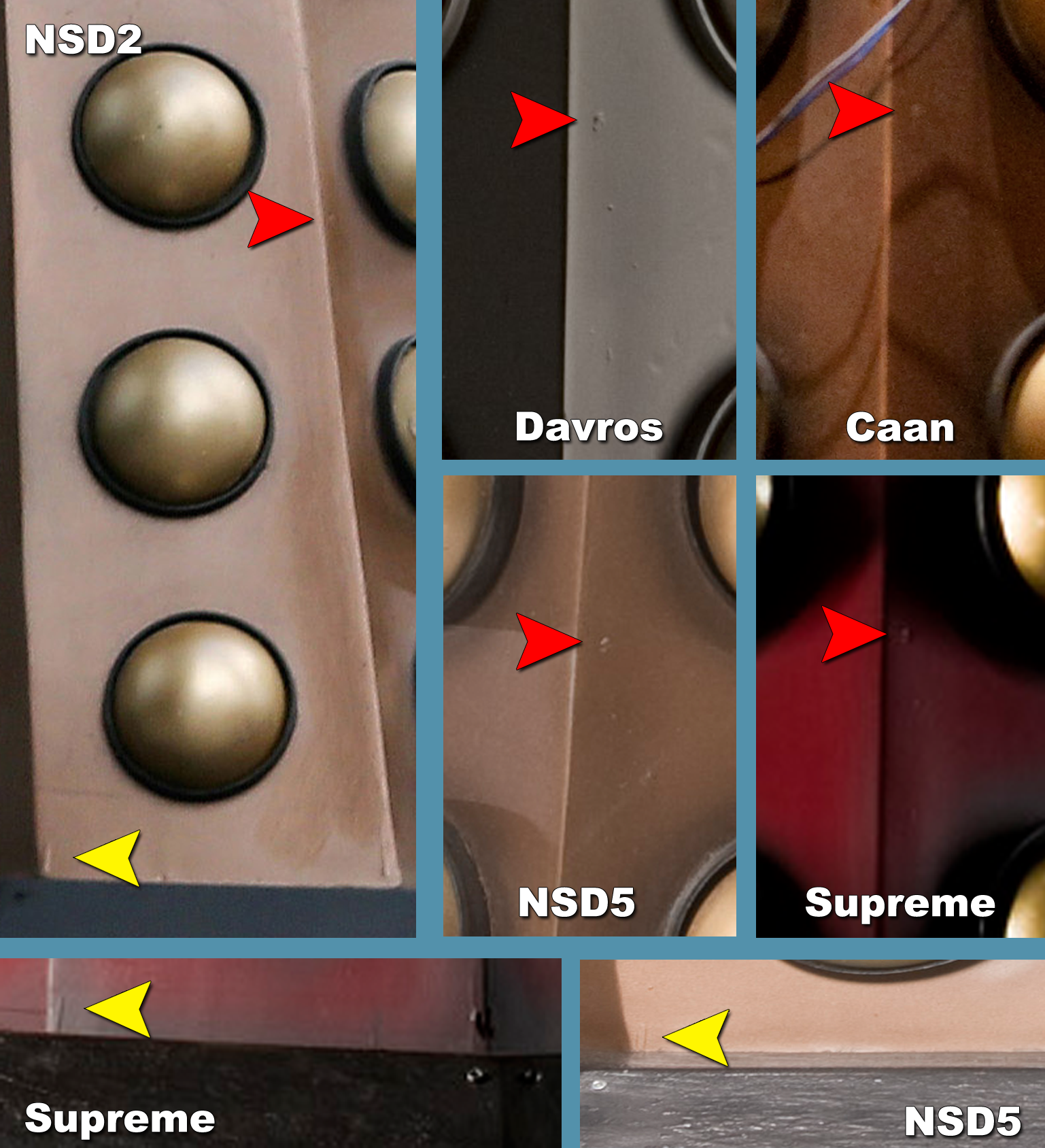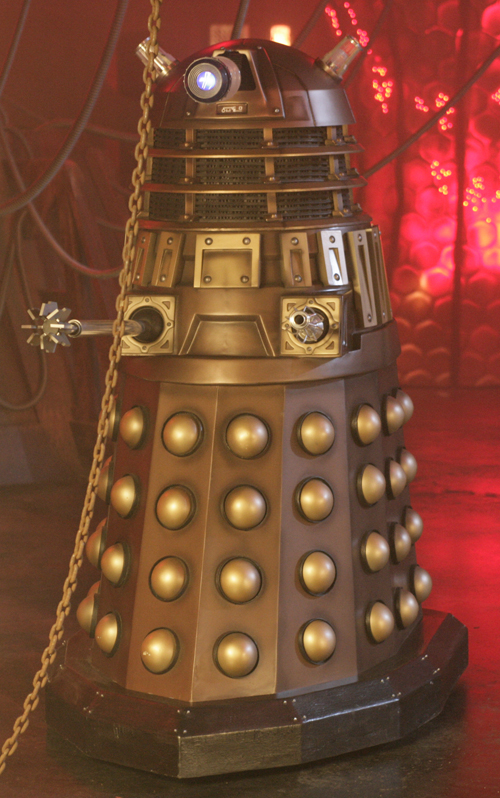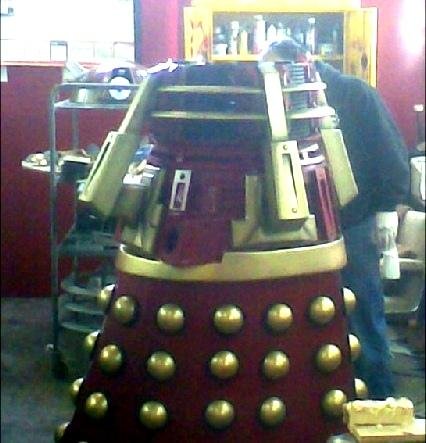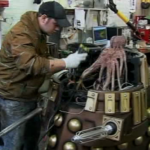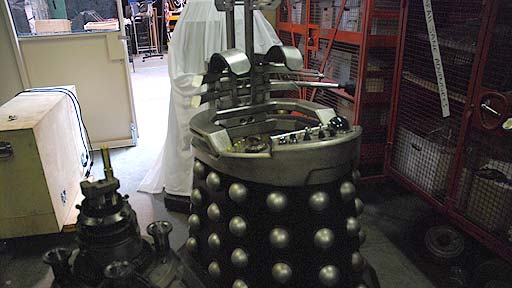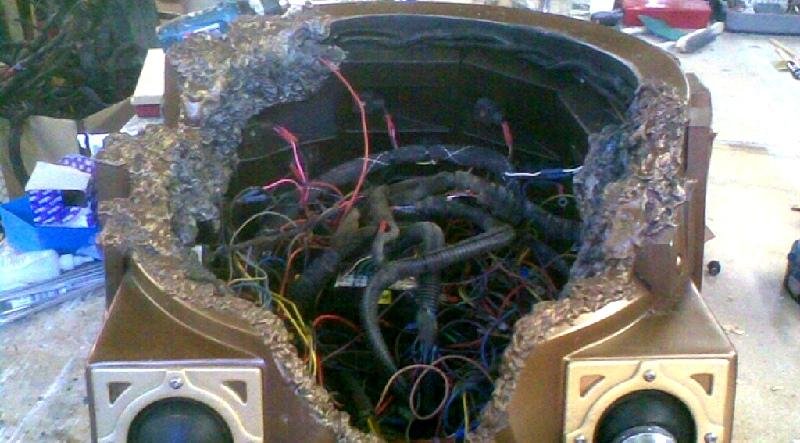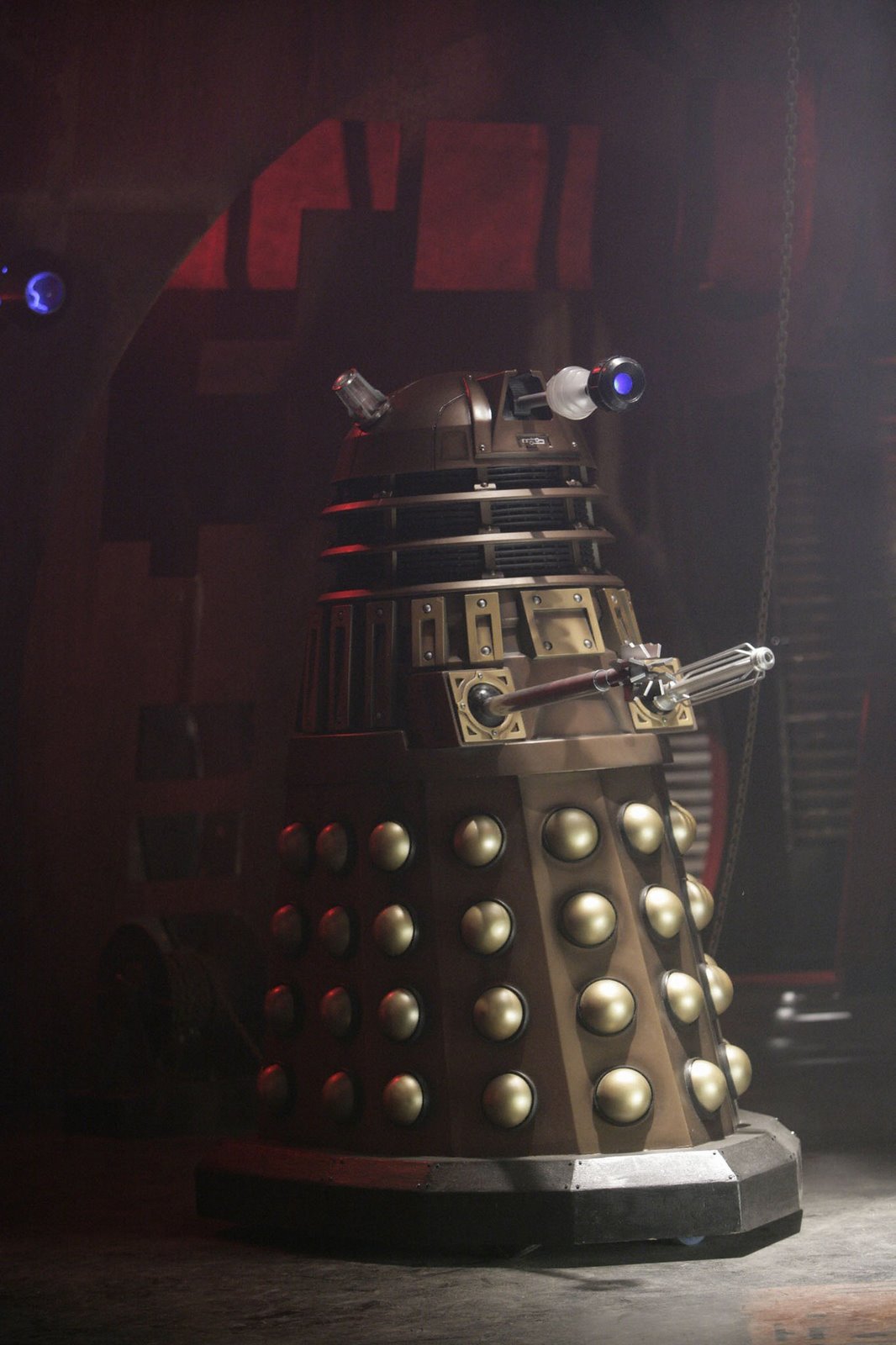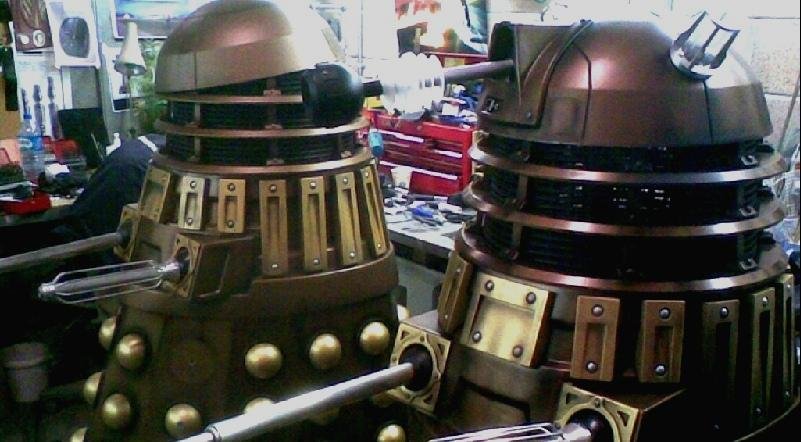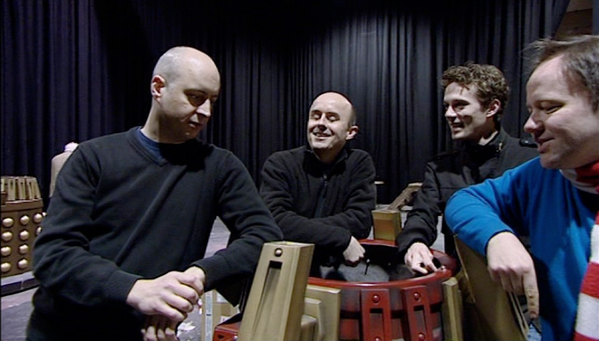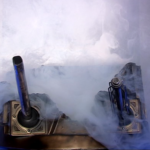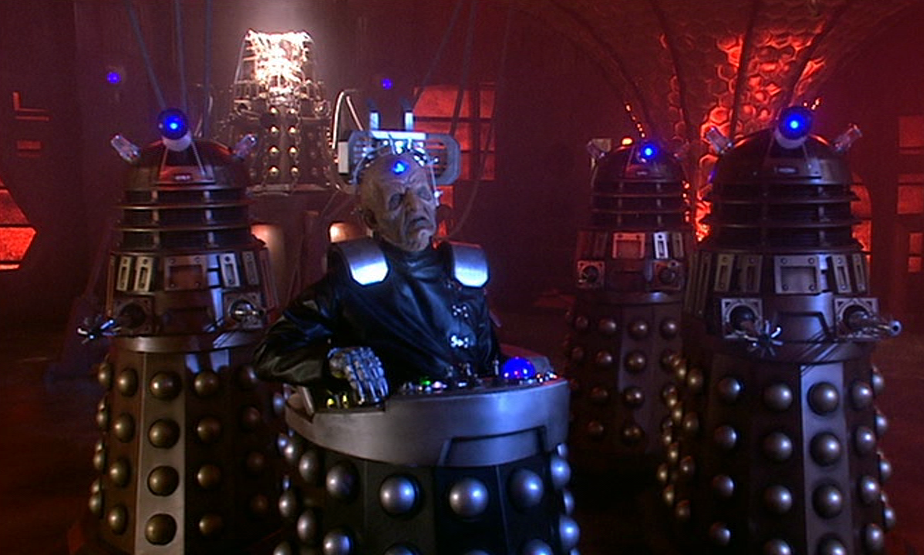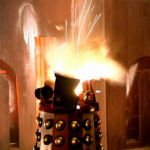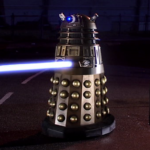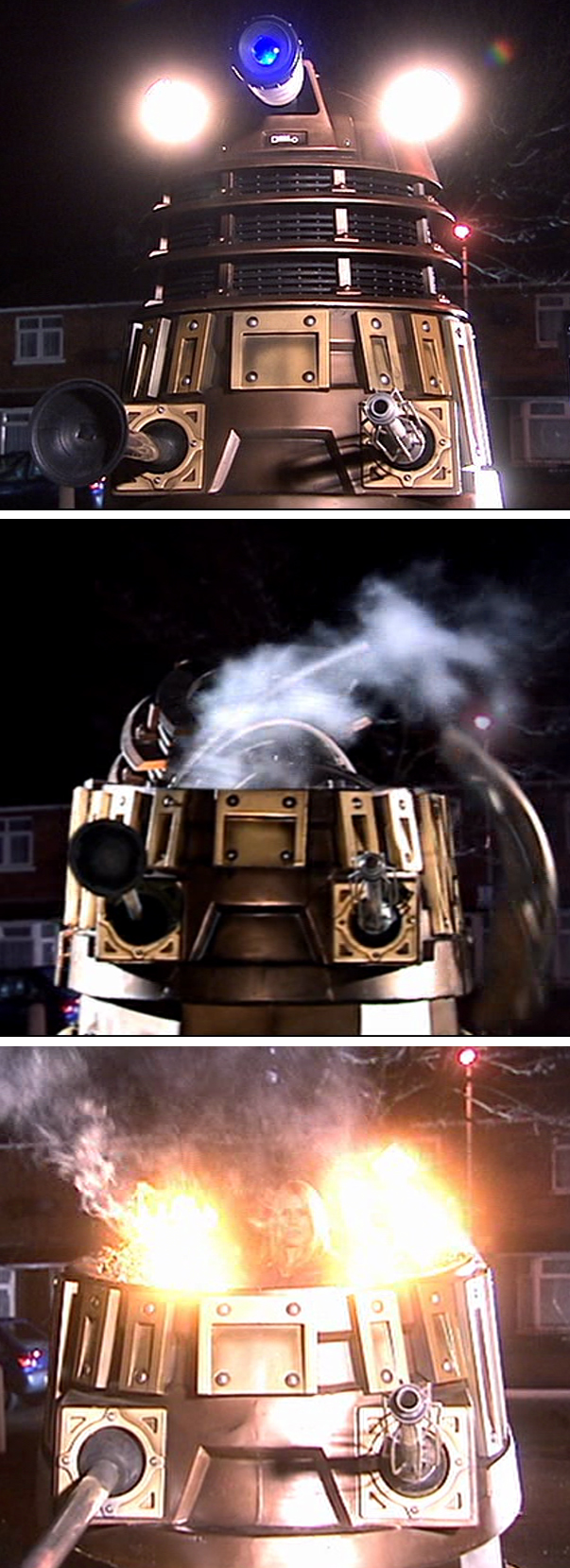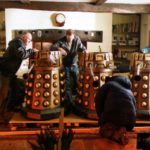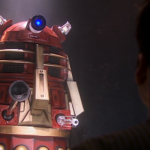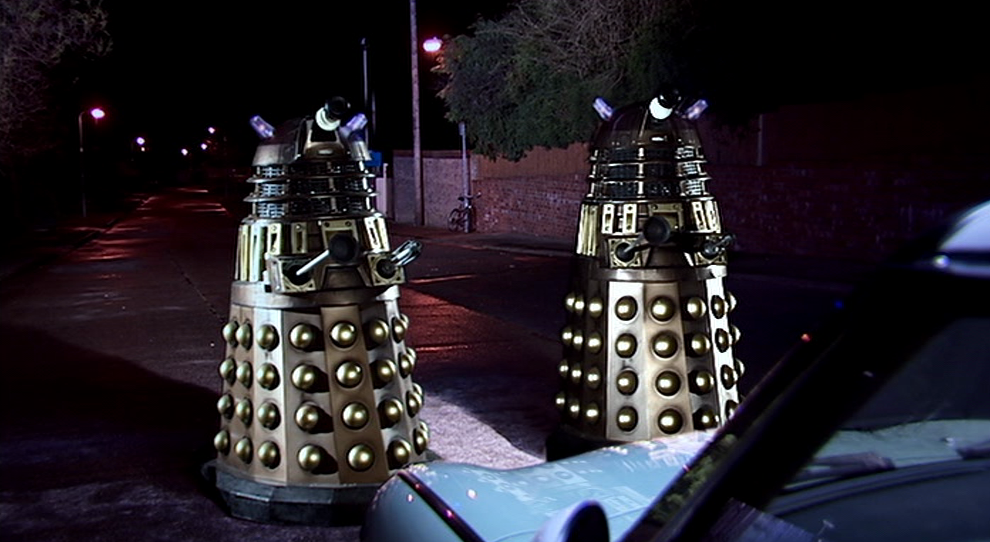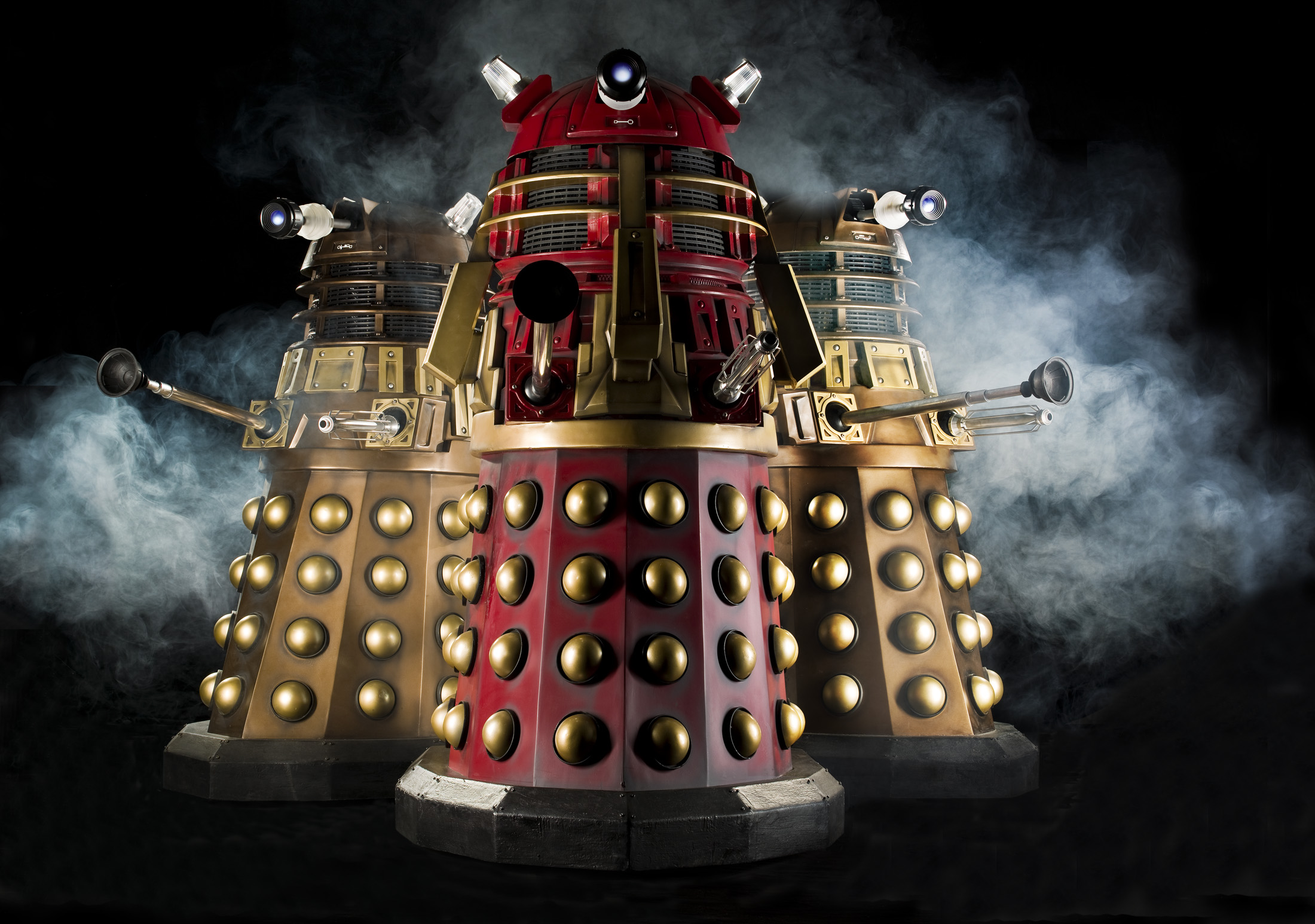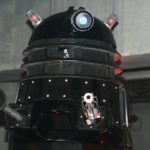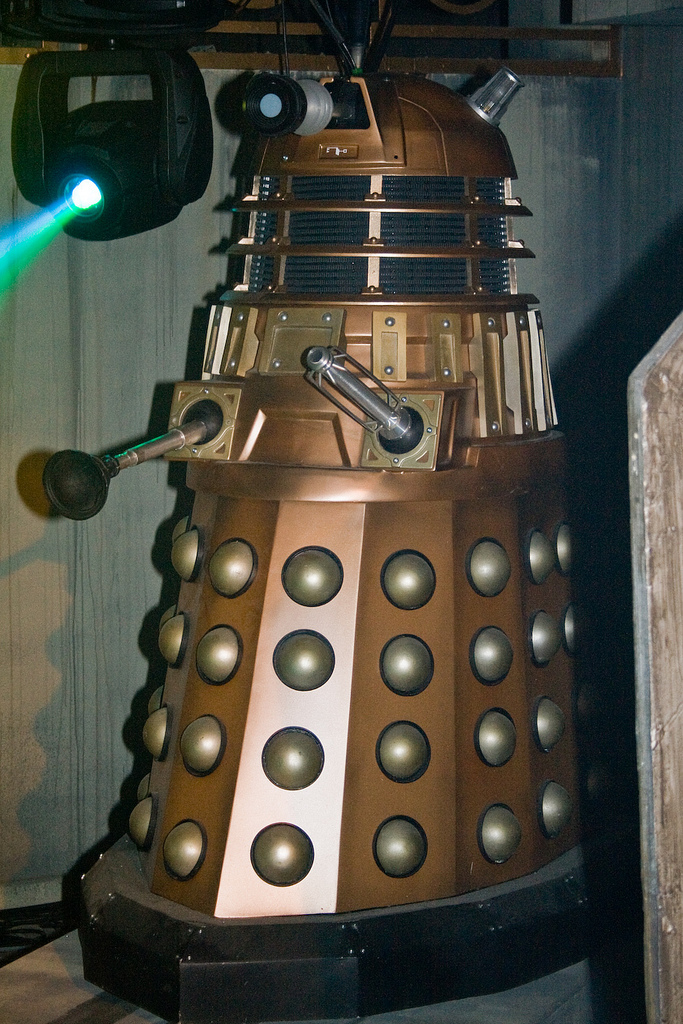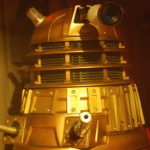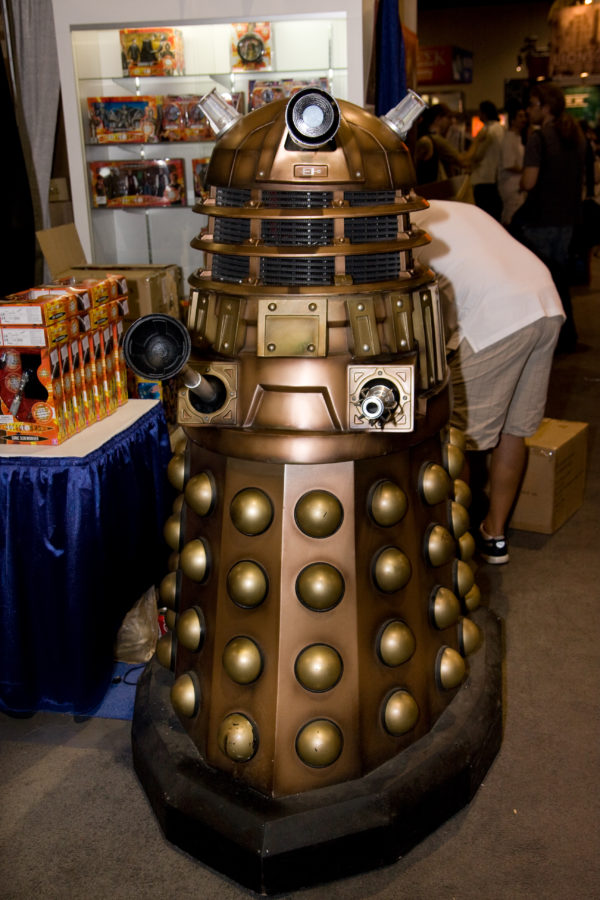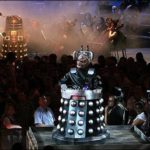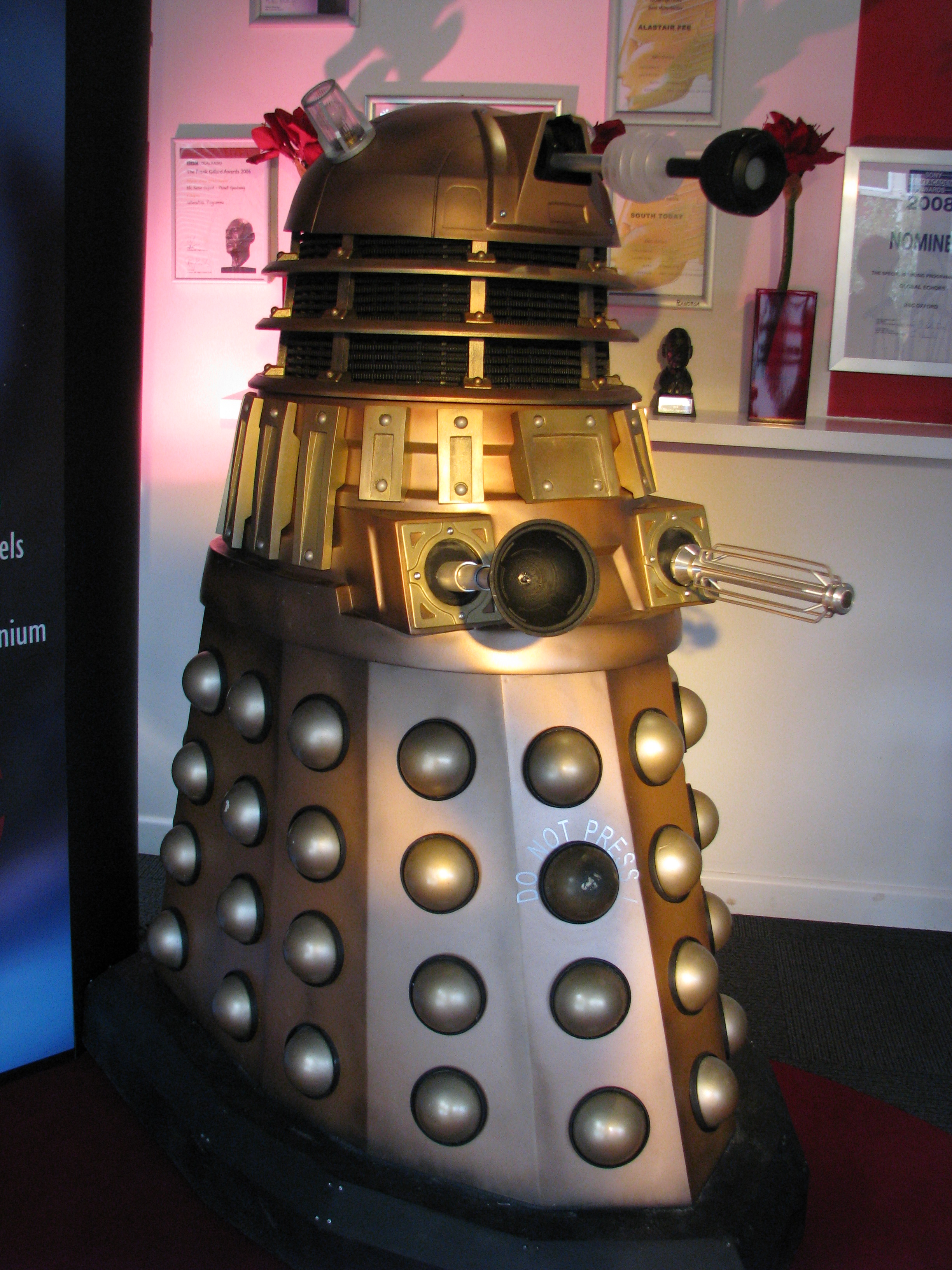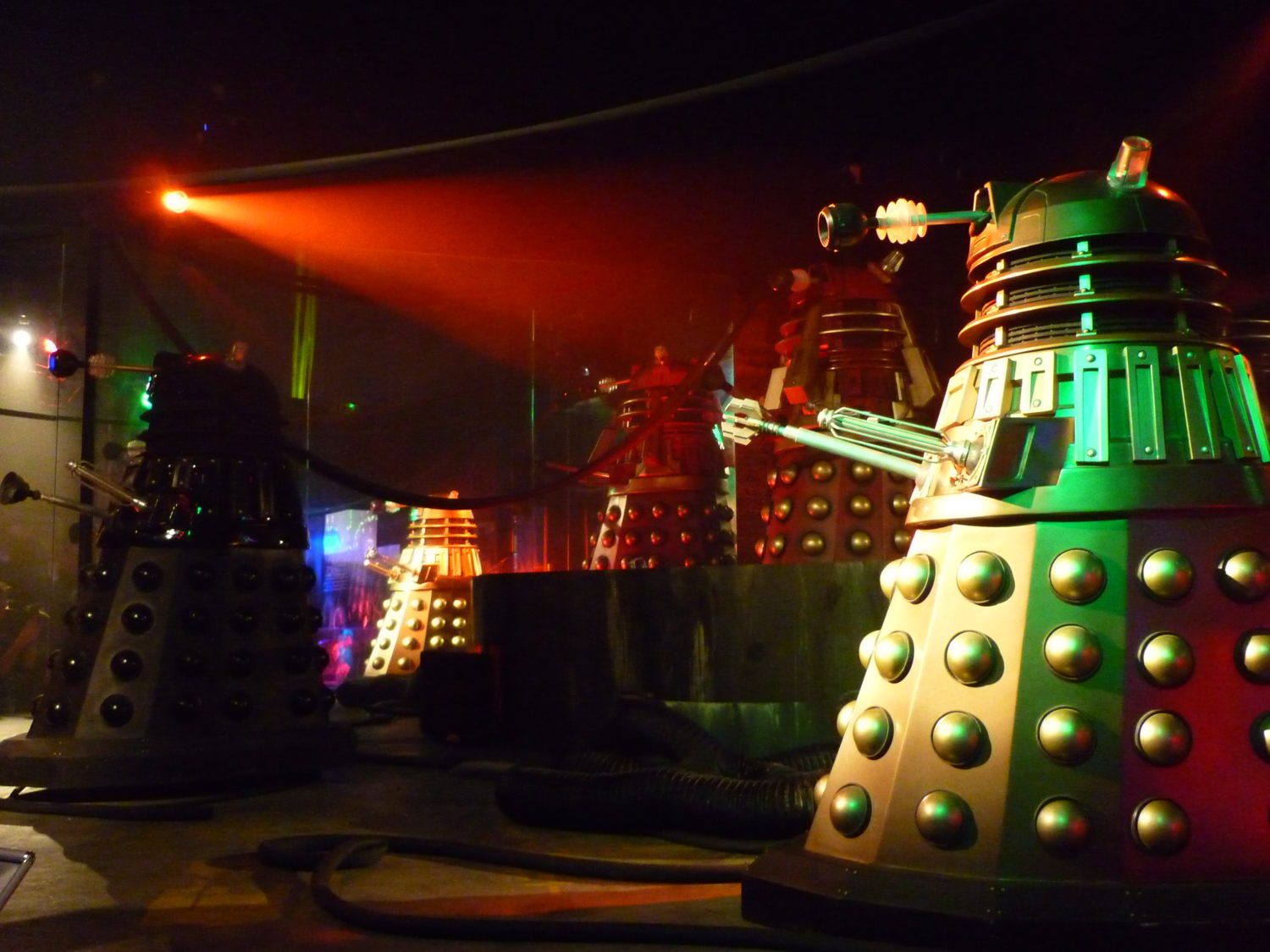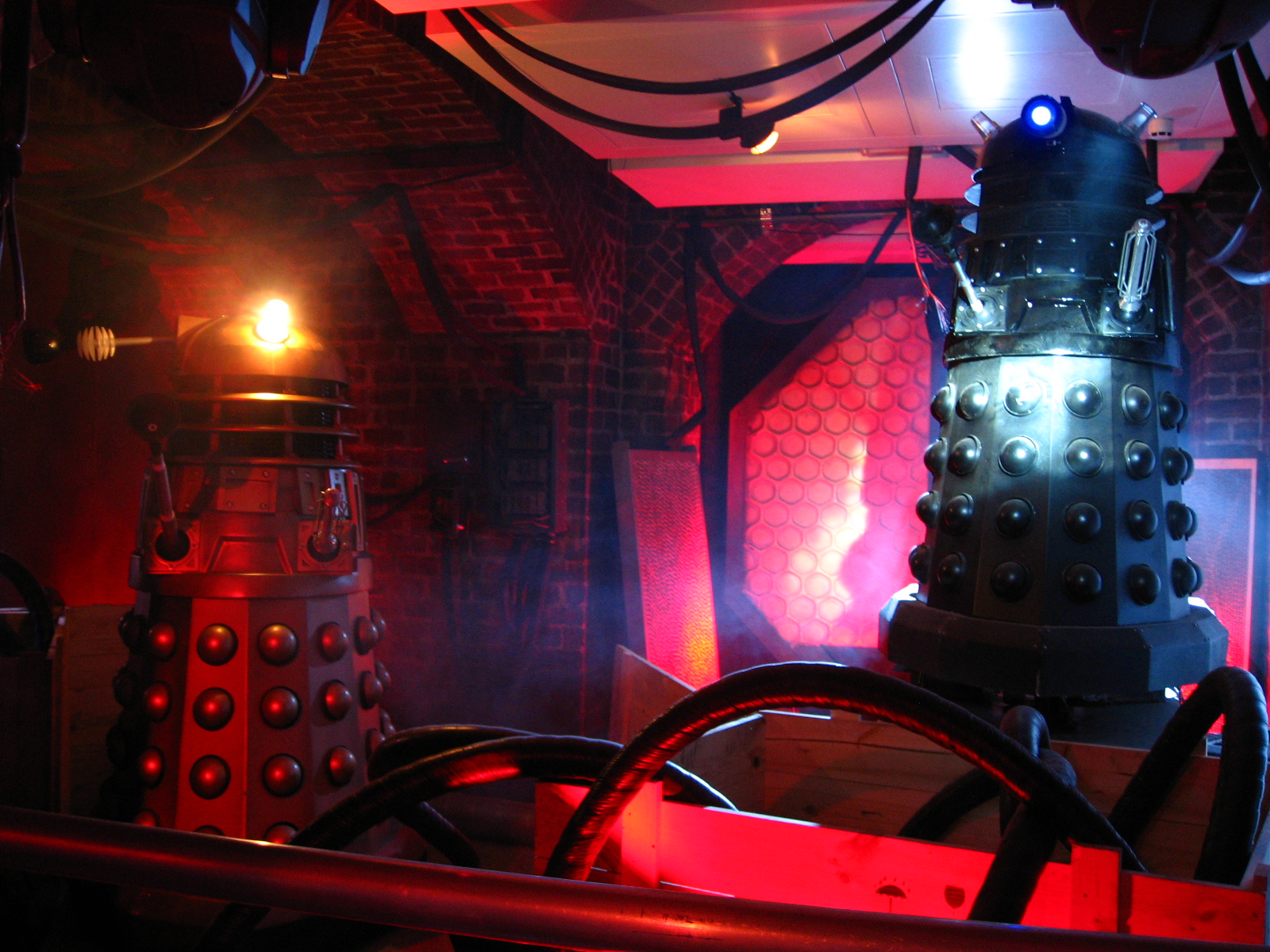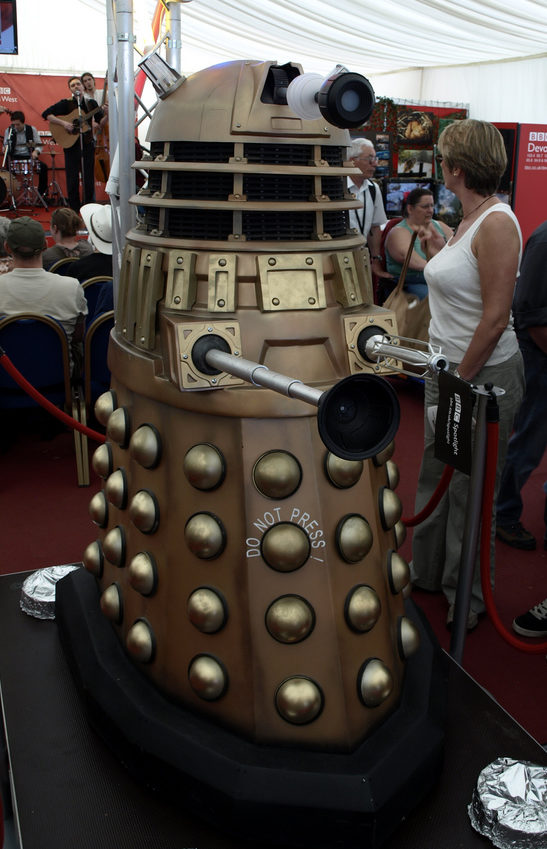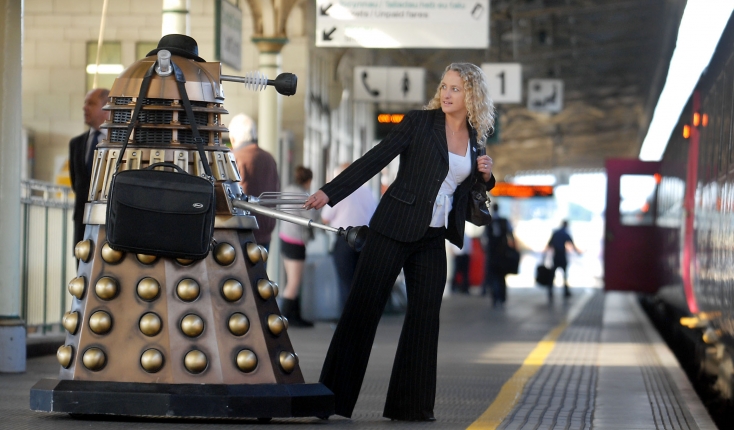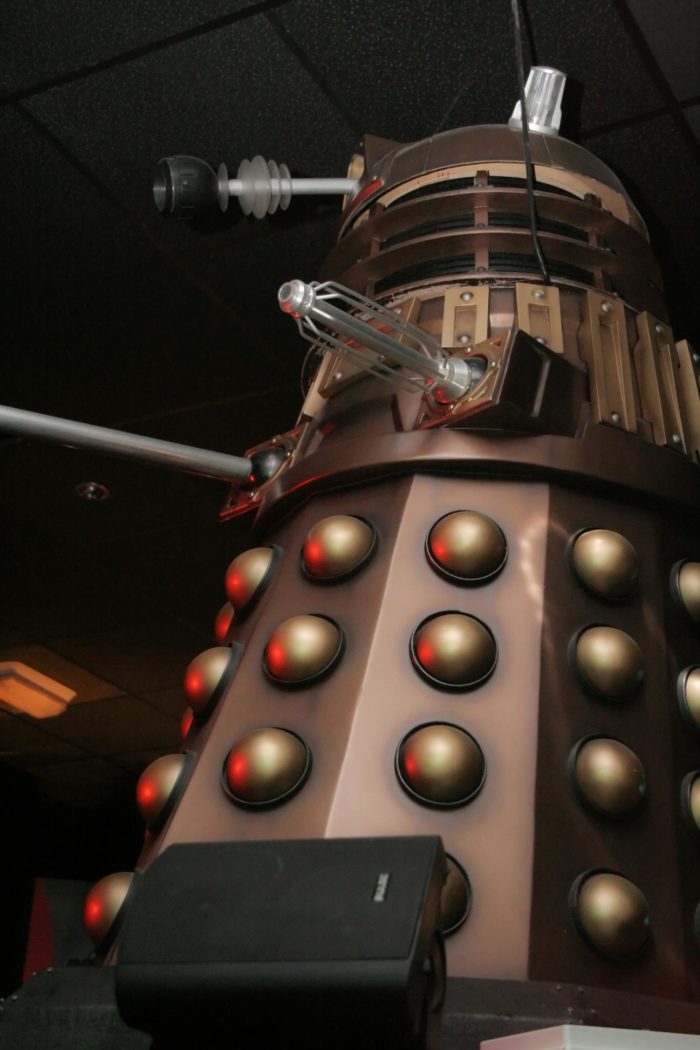The Stolen Earth & Journey’s End
As the David Tennant era began to reach its conclusion, show-runner Russell T Davies envisaged a spectacular finale for the final full season. Whilst a number of specials were planned for the following year, Series Four was the end of Phil Collinson’s time on the show and it was decided to draw together a number of strands to give a sense of completion to the run.
Unsurprisingly, the Doctor’s greatest adversaries returned once again but, to up the ante, they would be joined by two new villainous figures: Davros and the Supreme Dalek. With plans having been in his mind for the episode throughout the year, Davies finally began the script on 10th December and completed a first draft by the last day of the year.
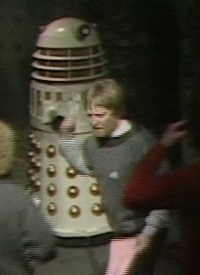
Graeme Harper in 1985
Graeme Harper was selected as director for the story. He had directed the Daleks in 1985’s Revelation of the Daleks and was already well versed in the use of Dalek props and the shows notoriously tight schedules. By this time, he was urgently in need of a script to continue to his preparations for the story. One certainty at least was the requirement of a set of Daleks for the episodes, plus the aforementioned Supreme and Davros, and work could at least begin preparing those.
The script for the second part was begun in mid-January 2008 and the scope of the story led to the episode being extended. The escalating cost led to many elements being cut from the script. Perhaps the biggest loss to Dalek mythology was the removal of scenes involving a young Davros experimenting on the Kaleds, and the depiction of the accident which led to his disfigurement.
With the delivery of the script behind schedule, production was already fraught before shooting had even begun.
A Supreme Addition
The job of designing the new Supreme Dalek was given to production designer Peter McKinstry and, with no outline in the script, he was able to be creative with is initial ideas. He suggested that a Dalek could be given greater status by being locked into a base-station, or throne.
The first draft of the throne design featured hexagonal panels around the bottom, and a hood. The Supreme Dalek prop would glide along a platform and lock into this enlarged shell, almost as if it was encased in armour. The Dalek would have a huge mushroom-shaped head, to emphasise this leader’s gigantic intelligence.
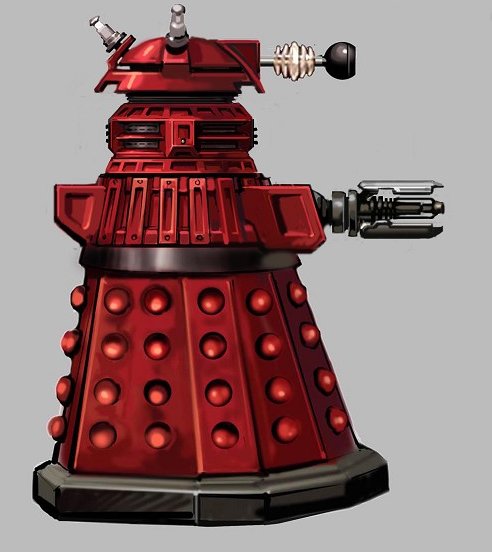
An early idea based on the Special Weapons Dalek
Other possible modifications included an enlarged eye, extra lights, and a flared dome rather like a Samurai warrior’s helmet. When the large-headed Dalek slotted into the base-station, the shapes cleverly connected together so that it looked like the Emperor from the 1967 story The Evil of the Daleks.
Unfortunately, a huge throne with moving parts could not be afforded, and so McKinstry was instructed to think about making it just a Dalek with some inexpensive add-ons to the head.
An early concept was based on the Special Weapons Dalek from Remembrance of the Daleks. Again, it featured a ‘Samurai Helmet’ style dome and a single large weapon akin to the Dalek that had appeared twenty years previously. However, Russell T Davies was unhappy with this direction as it implied the Supreme was a war machine rather than a being of superior intelligence.
Pressing on, and taking inspiration from the satellite Sputnik, McKinstry created a design which had a spherical head and four “antennae” which sprouted out and hung down. These metallic rods matched the design of the Dalek’s arm.
An initial idea to have a “goldfish bowl” head was scrapped, and McKinstry played around with the angles of the “antenna” and adding a fourth one at the front so that the upward-pointing arms didn’t look like a “surrender” gesture. A third light was placed at the rear of the dome at this stage too. The “antennae” were thickened and the neck was raised slightly, and, after ten days and dozens of design ideas, a truly Supreme Dalek design was born.
Russell T Davies was keen to have a red Dalek and right from the start all the various concepts featured red rather than a range of colour options that had been submitted for the standard Dalek design in Series One.
With the design completed, it was then turned over to the props team to build it. Due to the demands of the story, it was one of many new Dalek components which had to be constructed.
With thanks to Peter McKinstry
Davros
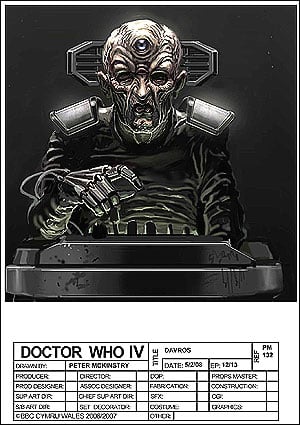
Peter McKinstry’s design for Davros.
Russell T Davies had always planned to bring back Davros at some point during his term as showrunner, but wanted to delay his appearance for extra impact. He also hadn’t found a way of bringing him back convincingly until Series Four. At one time, he had even considered that Davros could be found in the pit in Series Two’s The Satan Pit.
With the time now right, due consideration was given to exactly how he should be brought back. The original chair was on display at the Blackpool exhibition and the original mould used for the Terry Molloy version of the mask (as seen in the final three Dalek stories of the ‘Classic’ series) could also be located. However, despite being a move that would please older fans, the original chair would be unlikely to stand up to the scrutiny of a more sophisticated modern audience and the mask unlikely to fit Julian Bleach whom had been cast in the part. Also, the production and design teams were all keen creating a version that harked back to the ‘original’ Davros as portrayed by Michael Wisher in Genesis of the Daleks.
McKinstry was again handed the job of bringing the creation to life. His work concentrated on the chair as Neill Gorton at Millennium FX would be handling the prosthetics and Louise Page of the costume department would be creating the tunic.
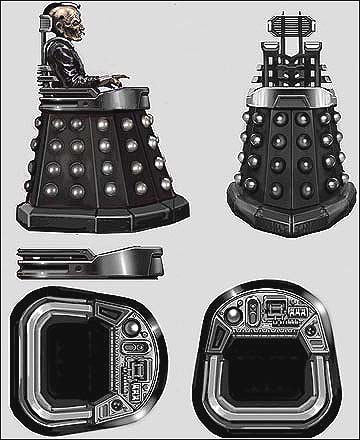
Concept art for Davros by Peter McKinstry
The design would need to be faithful to the original ‘Genesis’ version whilst being consistent with the new Dalek design. Therefore, a similar approach of bulking up the chair was taken:
“We wanted to get away from the slightly flimsy look of the earlier series. So I beefed Davros up, made him more sturdy.” — Peter McKinstry1
Whilst the original chair’s dimensions differed to those of a Dalek skirt section, this time it would be easier and more cost effective to use the same mould as used for the Dalek props. Only the control panel and back rest needed more work.
With the chair designs agreed, Neill Gorton sculpted a new ‘head’ that would become the basis of the mask. The design went through several modifications before the team settled on a version they were happy with. The mask was made from a silicone gel that was glued to Bleach’s face for each performance. Removing it, at the end of each filming session, would damage it and so several were made to cover the filming dates.
Davies admitted he hadn’t re-watched old Davros episodes before writing his script, therefore no strict effort was put into any continuity, however, one concession was made to previous tales in that Davros was given a metal hand which fitted in with Revelation of the Daleks where his own had been blown off.
Reunion
In February 2008, during pre-production of The Stolen Earth and Journey’s End, the original designer of the Daleks, Ray Cusick, was invited to Upper Boat Studios to take a look at how television production had changed since his retirement. Of course, along the way he was reunited with his creations. The historic event was filmed by the Doctor Who Confidential team for transmission at a later date.
He toured the Upper Boat studios with Ed Thomas and Peter McKinstry. When they came across the area holding the Dalek props there were only two. Thomas explained that the others were away at exhibitions. However, the Dalek prop that Cusick inspected closely wasn’t a screen-used production Dalek. It had been manufactured as a promotional Dalek for use by other BBC departments. Its weathering patterns differed to the existing screen Daleks and it also had a full ‘Cult of Skaro’ ID badge. The badge it copied had been partially worn away by the end of Series Three proving it couldn’t be the same prop. It had received a moment of fame when it was used for the Doctor Who Magazine cover shoot with Kylie Minogue the previous year.
Lurking behind this Dalek prop was NSD2. It was missing its dome and several slats. Some time prior, Will Sumptor had taken moulds of NSD2. The slats would have been removed to get the shoulder section mould and the prop was clearly in the process of being reassembled.
The Fifth New Screen Dalek
Despite having its skirt restored following the shooting of Evolution of the Daleks, NSD3 had made its last screen appearance and remained on display at the Blackpool exhibition. The team that would build the new Supreme and Davros’ chair would also need to replace one bronze Dalek.
With the involvement of Specialist Models having ceased a year previously in the Autumn of 2006, BBC Wales instead turned to their in-house team headed by Penny Howarth who worked alongside prop-makers Jason Hicks, Nick Robatto and Jon Grundon.
New moulds would need to be created from an existing prop which would allow a new bronze Dalek to be fabricated, along with the key components of the Davros chair and the Supreme which were largely unchanged from a standard shape. As seen during the visit of Ray Cusick, some time prior to pre-production starting on The Stolen Earth, Will Sumpter had taken moulds from NSD2. When Specialist Models created NSD2 and NSD3 from MT1, ‘errors’ in the original moulds were copied. This would be the case again with the new moulds taken from NSD2. However, in the months since its creation, NSD2 had received some areas of damage including some small ‘knicks’ and marks on the skirt section. These marks were therefore copied to the parts made from the new moulds. The Supreme, Davros, the new Caan prop and the new NSD5 all shared the same issues on their skirts as NSD2.
Howarth’s team swung into action and each member was given specific tasks to do. Grundon cast out the required fibreglass sections and painted them whilst Howarth made the neck rings and detailing. Robatto created all the new guns, arms and eyes.
Great lengths were taken to ensure the new bronze Dalek matched the originals as closely as possible but, as with all Daleks, differences are present for a variety of reasons.
The method of casting the fibreglass components and the amount of sanding influences the final finish of the prop and the newer skirt and shoulders have a slightly rougher surface to the earlier props.
All the existing Daleks were refurbished for this story and, as a result of a new coat of dark grey paint on the fender, the hex-bolts which adorn the sloping edge were painted over. The new prop NSD5 therefore stands out as having bolts on the fender which are still metallic because they are new.
There are minor imperfections in the prop which can also be identified. The seam down the front of the shoulders (where the two halves of the mould join) had not been absolutely sanded away. In certain lights, a bobbled surface can be perceived. This effect is accentuated by the fact that on the front slat a little weathering appears directly in the centre which continues this line. The two small slats over the arm-box are rotated clockwise slightly.
The hemispheres are fractionally smaller than had been used previously and, as a result, there is a greater gap between them and the oil seals in which they sit. The hemispheres are also not always accurately located within each of their seals so some are touching the rim.
One key difference is that the position of the shoulders on the skirt is different to other Daleks. The original Dalek MT1 had its shoulders mounted on the skirt in such a way that that the back of the shoulders and skirt form a fairly straight “spine”. The Specialist props were all moulded from this same Dalek and their shoulders and skirt were created in one piece so they share the same straightness.
The new NSD5 has its shoulder and skirt created in two sections and when the holes were drilled to allow fixing bolts to keep them together, the shoulders were slightly further forwards than on MT1. The result is that there is more of an overhang of the shoulders at the rear of the prop.
The team also began to use a number of slightly different styled components. Robatto created a new type of gun which was machined with very slightly different proportions. The angle at which the rods attach at the back was thicker and the nozzle at the end protruded further. The bulb-holders for the lights were taller than had been used before so that the interior of the lenses was filled more.
A Mad Dalek and their Masters
To create the Supreme Dalek, the same system employed in making NSD5 was carried out again. Therefore, Howarth, Grundon and Robatto created all the main sections and standard Dalek parts with Jason Hicks making all the special new additional parts.
Two more Dalek skirts were created at the same time – one for Davros and one for Dalek Caan, and the latter also featured a whole new upper half. This was built in the same manner as the Dalek which had opened up at the end of Dalek but, despite the original opening section still being available, this was another new build. Penny Howarth and Jon Grundon dressed the new section with wires and a foam substance to simulate a form of living tissue. Neill Gorton at Millennium FX supplied another animatronic Dalek mutant to sit in the opened section. The mutant was taken from the same mould as the original Dalek mutant although a complete new animatronic mechanism was required as the original had been destroyed when it was used in the tank for the Emperor Dalek in the series one finale.
As Caan was supposed to be damaged already, less time and effort was devoted to making the prop look perfect. Looking carefully at the areas of the prop which are obscured, the hemispheres on the left side are misaligned and the long slats behind the gunbox bear some curious features.
The team created two separate moulds for the long slats, each of a different length and with bolt hole positions in a different place in relation to the lower edge of the slat. This is because of the curvature of the shoulders, a longer slat is required towards the rear of the prop. However, due to the speed with which Dalek Caan was constructed (and it’s rough appearance) no thought was given to which length was appropriate and so the slats are uneven.
Jason Hicks then completed the Davros chair by creating the complete top control panel section and back rest.
In addition to the different types of hero props, Scott Wayland supplied a number of FX props for the story which were comprised of shoulder, neck and dome sections with cut-away parts designed to blow out and collapse easily. These would be used in scenes such as when Rose destroys a Dalek. The cutaway section at the rear would allow a view that would be impossible with a normal prop.
Wayland was asked to lend his own complete Dalek to the production. It had been created as Dalek Sec and the SFX supervisor, Danny Hargreaves, asked permission to repaint it bronze. Ultimately the Dalek was never used and Wayland received his prop back still painted black but this Dalek would receive its moment of fame some years in the future.
The in-house team also created a complete pre-damaged shoulder section, revealing inner workings, that was used for a close up shot in the Torchwood Hub scenes.
With thanks to Jon Grundon
MT1 Returns to Bronze
With the character of Dalek Sec having met its demise in Evolution of the Daleks, a black casing was no longer required and so the original prop MT1 was returned to its original bronze colour. The most obvious “tell” of this first generation prop is the extremely sharp corners on its collars. It has a neat right-angle on the overhang above the skirt, whereas the newer Specialist props were rounded off.
With the prop having had a full repaint, the fender was also brushed over with a new coat of grey. This obliterated the reflective metal of the hex-bolt heads which adorned the surface.
Other small details which distinguished MT1 could still be discerned under the new bronze, such as a mark in on a neck rod at the front of the head. The cage of of the original prop was made of wood and one circular feature in the surface could still be made out in the same position as in its previous incarnation.
Similarly, on the very top edge of the skirt, in a position where a ‘Specialist skirt’ surface begins to be “blend” into the collar, a diagonal imperfection in the surface of the fibreglass can still be seen after its bronze repaint. Also still present was a ‘dribble’ mark between the two top hemispheres on the front left panel. This was a liquid residue from the FX shot that the skirt was involved in back in Series One. These unique identifying features demonstrate that it is certainly the same Dalek Sec prop continuing to be used in Series Four.
With the return to its bronze colour scheme came new weathering and, as with the Specialist props, this particular pattern of oil streaks becomes by far the easiest method of spotting this prop in future. For example, on the Dalek’s left side panel, a very prominent double oil run is beneath the top rear hemisphere, and a vertical line connects both the bottom two rows.
It was the first time MT1 had functioned as a normal Dalek in three years.
The two other Specialist props, NSD2 and NSD4 were given some refurbishment and in doing so, began to inherit new types of component as replacements were fabricated and parts swapped over. The new type of gun made by the Robatto team was fitted to NSD2, an NSD4 was given a new dome. As a result it features the stepped eye-discs like the new NSD5. In the pressure of the frantic schedule, little care was taken in reattaching the slats back onto NSD2 after it was dissembled for moulding. The first two long slats were reapplied upside down and remained as such throughout filming.
Masters of Earth
The Stolen Earth was a demanding shoot requiring all four bronze Daleks to be used in both studio and location work. Filming between the two alternated allowing for actors schedules and different sets to be created. Barnaby Edwards, Nicholas Pegg, David Hankinson and Anthony Spargo reunited for operating duties.
With the Daleks fulfilling a ‘drone’ role in the tale rather than the specific characters that had for the previous two stories, the ID badges needed regular changing to give the illusion there were many different Daleks. Rather than directly painting on the ID or applying a decal, a number of bronze stickers were made with various ID designs on them. They were applied to the various props and changed at regular intervals in both studio and location work.
Amongst the initial studio work beginning in mid-February at Upper Boat were the scenes set in the Torchwood Hub. MT1 was required here to portray the Dalek sent to destroy the members of the Torchwood team. For its ultimate demise, the special shoulder section created by Penny Howarth’s team was used. Much effort had been put into bulking up the fibreglass to make it look like the casing of a Dalek was very thick metal. Lots of internal works and cables had also been added. However, much of the detail was obscured by the smoke that was added to complete the illusion of the recent explosion.
The 3rd March saw the first major work in studio with the four Dalek props – MT1, NSD2, NSD4 and the new NSD5. The recorded scenes were set in the Crucible Vaults and therefore featured Davros and the Dalek Caan prop. All four props were given a new attachment on the arms. It comprised of a series of ‘fins’ that could be inserted into various controls in the set. Most of the work for the Daleks was fairly standard fair with Davros taking the bulk of the limelight. Several lightweight Dalek upper sections were used for the explosive ending to the story.
The Supreme Dalek also made its first appearance here for its brief ‘Vault’ scene before being destroyed by Jack. Another FX upper section with precut parts was placed on the hero skirt for the shot. Instead of a rough approximation of the hero upper section, a ‘standard’ Dalek section painted in red an gold was used. A quick edit was used to hide the sudden change.
14th March was the first use of a New Series Dalek prop in an external location shoot since the shows return in 2005. MT1 was the Dalek that nearly manages to kill the Doctor in the scene where he reunites with Rose. Filmed in the High Street area of Penarth, the prop was placed on tracks to aid with a smooth movement into shot. Captain Jack eventually destroys the Dalek. One of the lightweight FX shoulder and neck sections was substituted and quick editing hid the change. A curiously large CGI collar helped to hide the join between MT1‘s skirt and the top section. The scenes of the four Daleks transferring the TARDIS to the Crucible were also filmed at this time.
The following day, all four Daleks were used in Brook Street in Cardiff in the scenes of Daleks rounding up humans. Boards were placed on the pavements to aid smooth movement. Also filmed on this night was the shots of Wilf and Sylvia confronting a Dalek with a paint gun. Again, MT1 was the prop selected for the scene. Its demise at the hands of Rose utilised two SFX sections. The first was a similar construction to those that had gone before, that being an upper section with precut sections ready to fly apart. The second was a specially made shoulder that had a rear section cut out (as Rose had shot it from behind) so that the filmed sequence could reveal Rose through the mutilated Dalek. Quick editing again allowed a seamless completion of the effect.
The 16th saw the team move to the disused Alpha Steel building in Newport for the Reality Bomb testing scenes. Again, all four props were used and CGI enhanced certain shots to include many more Daleks.
For the Dalek attack on Harriet Jones’ house, filmed on the 18th March at Lower House, Michaelston-le-Pit, only three of the props were used. Due to the difficult nature of getting the props through the location’s patio doors, another specially raised section of boards was used. NSD5, MT1 and NSD2 were able to move smoothly into shot to exterminate the ex-Prime Minister.
The team returned to the studio on 20th March where the Crucible Vault had been redressed as the Command Deck. The Supreme Dalek completed most of its major work here. Due to its construction, the eye of the Supreme could not look downwards. This presented a problem with the prop being situated on top of a high dias. When the the Doctor had to confront the Supreme Dalek the prop couldn’t see down to him. Therefore, in one scene, the prop was lifted at the rear and filmed in such a way that it hid the lifting mechanism and attempted to hide the odd angle the Supreme was now placed in.
All four bronze Daleks were used again and were re-fitted with the standard plungers. In an idea that harked back to the very first Dalek story on 1963, a full sized ‘cut-out’ of a Dalek was also used at this time. It was placed behind a perspex screen that represented a doorway and then lit from behind. The resulting effect left a silhouette of the Dalek appearing to be behind the door.
The team moved back onto location again on 25th March. The scenes of Sarah Jane’s car getting blocked by two Daleks were filmed in Robinswood Crescent, Penarth. MT1 and NSD5 stopped the car but, of course, in classic ‘Who’ style, both were destroyed in the nick of time, this time, by Mickey and Jackie. The effect was achieved slightly differently to previous Dalek destruction scenes. MT1 was filmed exploding twice (with SFX top sections) and both versions were overlayed into a shot looking from the side of the car. The perspective in the final shot looks slightly odd but was only seen briefly.
The long and hectic filming schedule concluded on the 31st March.
Invading Earls Court
With the fourth season ‘in the can’ the producers switched to promoting the new season which was due to begin just a few days after the wrap. The usual rounds of press interviews and TV appearances began in earnest with the Dalek tale due to air over two episodes in June and July.
As with previous Dalek episodes, the Radio Times seized the chance to grab some promotional opportunities. Davros featured on the cover in June 2008, and there were articles on himself, Caan and the Supreme inside. Readers could also send away for a large double sided poster featuring the new villains too. For the poster, the Radio Times had arranged a photoshoot with Davros, The Supreme and two Dalek props. The Daleks featured were MT1 and NSD4.
The BBC continued its use of exhibitions to take the programme to the public. The Lands End and Cardiff exhibitions remained open but the displays at MOSI in Manchester and the National Space Centre at Leicester had recently ended and with a number of props now available, a large display was opened at Earls Court at Easter 2008. As with most of the displays since the return of the show in 2005, it was mainly items from the New Series that featured. The Daleks were there in numbers.
The animated display set-up at the Land End Exhibition in 2007 had proved a great success and so another larger version was created. TPE-SEC2 transferred from Leicester and was flanked by two new ‘This Planet Earth’ bronze Daleks. The camera had been removed from the neck of TPE-SEC2 which left an unsightly hole. An initial attempt was made to cover this with tape but the repair soon peeled off.
The duplicate Dalek Sec was placed towards the rear of the set on a revolving mechanism. As he turned the two new Daleks moved in on tracks either on either side. The props were fitted with lasers which would shoot over the attendees heads. Both the new bronze Daleks had identifiable features. TPE-EC1 (This Planet Earth – Earls Court 1) had one of its lower hemispheres on the front panel poorly positioned and the large centre slat of TPE-EC2 was rotated slightly so that it wasn’t level.
Later in the year, once Journey’s End had been broadcast, Davros also joined the display using the original control panel, skirt and fender. A cast of the new mask was taken to place on a torso. He was also given some movement in that the head would move from side to side and his fingers ‘drummed’. Some of Julian Bleach’s performance in the televised tale was played out during his section of the display.
Also featuring at Earls Court was one of the original exhibition props that had been made by Specialist Models – NSDW. It had been last seen at MOSI in Manchester and was set in a separate section to that of the animated display along with the ‘half’ Dalek display.
Invading The Country
With the popularity of Doctor Who riding high again, various BBC departments across the country wanted a piece of the action. Television Centre in London was no stranger to Dalek props, despite production of the New Series taking place in Cardiff, and was obviously a prime position for promotion. The BBC staged tours of the Centre and TPE-TVC had been stationed there for visitors since 2007. NSD3 had also had a brief stay there in the same year. In May 2008, both MT1 and NSD5 were sent from Cardiff for display at TVC. The visit proved to be opportune for Doctor Who Adventures Magazine. Short of images of Daleks, they were able to set-up a photoshoot at short notice and get the pictures they required.
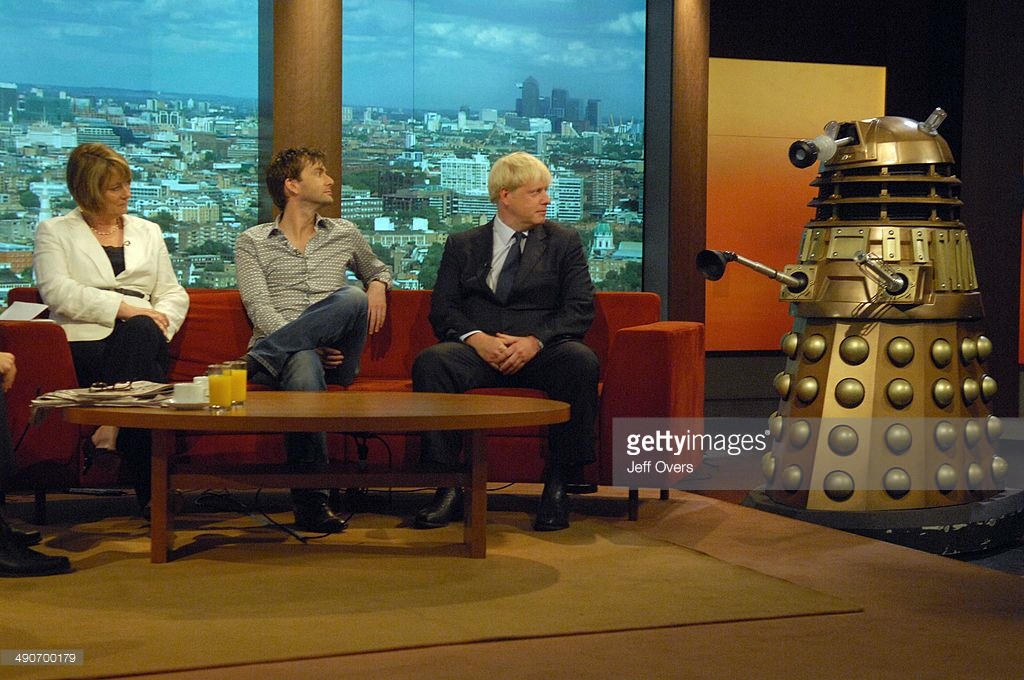
TPE-TVC features on the Andrew Marr Show with David Tennant and Boris Johnson. Picture – Getty/Jeff Overs
Soon after both MT1 and NSD5 were requested elsewhere. MT1 travelled to BBC Birmingham which, when not on TV, would become its adopted home. TPE-TVC got a starring role on TV on 8th June when it appeared on The Andrew Marr show alongside David Tennant and the then London Mayor, Boris Johnson. The prop had suffered at the hands of the public – its dome was now lopsided and the sucker has been taped back to the arm.
From TVC, NSD5 travelled north to Harrogate to appear at the Great Yorkshire Show in early July. It was an event that was in its 150th year and this show was to be attended by the Queen. As had NSD4 in 2007, NSD5 formed part of a BBC stand promoting local radio and TV services. Later in July, the Dalek moved to BBC Scotland in Glasgow as part of the Glasgow River Festival. In September, it moved back south, to the BBCs New Broadcasting House in Manchester. Like MT1 at BBC Birmingham, NSD5 would now be homed at BBC Manchester unless it was required for TV use or other BBC department use.
TPE-C had another busy year. In February it had been sent to the Forbidden Planet store in New York and from there moved to San Diego for another stint at Comic Con. The prop had been given a little refurbishment for the trip to the USA.
The success of the ‘Celebration’ concert in 2006 prompted another similar event in July 2008. This time the concert would be part of the BBC Proms held at the Royal Albert Hall. It was performed on 27th July and featured music from the show along with space themed classical music such as Gustav Holst – The Planets.
A whole musical section was devoted to the Daleks and, of course, they also appeared live on stage too. A brief introduction was recorded in a corridor of the hall and was played in on screens. NSD4 was the prop recorded and then appeared on stage to menace conductor Ben Foster. The prop was operated by Barnaby Edwards and voiced by Nicholas Briggs. Julian Bleach also made an appearance as Davros, rising from the centre of the auditorium to wow the audience. NSD4 then returned to Cardiff where it could be seen as part of the studio tours.
Press My Hemisphere
News of the Daleks appearing at various BBC local stations was starting to spread and more wanted to get one themselves. This Planet Earth supplied yet another Dalek which first appeared at the BBC Oxford Open Day on 27th September. Like previous versions, this Dalek was animated, but instead of having a separate stand with a button, this time one of the Daleks’ own hemispheres became the button with some text applied around it inviting the public not to press it! We call this Dalek TPE-BBCOx (This Planet Earth – BBC Oxford). After its visit to BBC Oxford, it then immediately moved on to BBC South the next day to be part of their open day. BBC Merseyside also took delivery of a This Planet Earth Dalek for display around this time.
Towards the end of 2008, big changes were underway at the Cardiff Exhibition too. With the success of the animated Dalek displays elsewhere, a new set was devised for Cardiff. The existing Daleks – NSD-B and TPE-SEC were moved to a larger display and joining them was the complete hero Dalek Supreme prop. As with its ‘twin’ TPE-SEC2 at Earls Court, TPE-SEC was placed on a rotating mechanism to spin around to look at the Supreme Dalek which rose up at the rear of the set. NSD-B was fitted with the new ‘fin’ attachment that had been seen in the recent tale and all three Daleks were fitted with lasers.
In November, a small set of props appeared at the Kelvingrove Gallery and Museum in Glasgow. It was a preview for a larger scale exhibition that was due to open the following year. Forming the small collection was K-9, a Hath and TPE-C which had returned from its stint at the 2008 Comic Con in San Diego.
The End Of The Road?
David Tennant’s final year as The Doctor in 2009 comprised of several ‘specials’ rather than a full scale season. As the Daleks had been the big draw for the finale of season four, it was another enemy – The Master, that would return for Tennant’s final tale. The Daleks, or rather a single Dalek, did make a cameo appearance during The Waters of Mars. It was a CGI model used for the full Dalek shots but an extreme close up of an eye and dome of a hero prop was also used. The ID Tag on the dome would go on to be seen in a future Dalek story associated with NSD5.
Even with the Daleks off the screen, they were still guaranteed to pull in an audience. Two new exhibitions were opened in 2009 and again made use of animated Dalek displays.
After the preview in 2008, the full scale exhibition opened at Kelvingrove in Glasgow in January 2009. TPE-SEC2 and TPE-EC2 were transferred from the, now closed, Earls Court display. The Dalek display worked in much the same way as Earls Court with the exception of the missing TPE-EC1 that would appear elsewhere later in the year. TPE-EC2 spent a period of time at the display with its dome facing the rear of the set. TPE-SP also made an appearance in a separate display having been in storage since it last appearance at the Spaceport in 2007. The ‘half’ Dalek first seen at Earls Court was also moved to the exhibition.
A display of props opened at the Coventry Transport Museum in March 2009. For the Dalek display, NSD-W and TPE-EC1 were set up in a small area. NSD-W was fitted with a laser to match its counterpart and, as at Earls Court, TPE-EC1 moved into the set on a set of tracks. The animated Davros prop also made an appearance too.
Continuing a trend of visiting rural shows, TPE-BBCOx was on display at the Devon Show at Clyst St. Mary in May. After its stay it was transferred to Television Centre in London where is remained on display for visitors. In July, TPE-C made its third trip to the San Diego Comic Con. NSD5 was also on the road again in July when it spent a short time at BBC Radio Leeds before returning to New Broadcasting House in Manchester.
Specialist Models own Dalek, NSD-S, was back in the public eye when it was used for a promotion for Cardiff in October 2009. The prop was borrowed by Cardiff & Co and various pictures were taken in and around Cardiff train station. It was hoped that the promotion would help to attract business and investment into Cardiff. This Dalek had a moment of fame on television when it appeared in Eastenders in February 2008.
In November, the second Blackpool Exhibition closed its doors for the last time. As with the original exhibition in Blackpool, it was a sad time for many fans. Although the second version perhaps didn’t have the same nostalgia factor of the first, it was the only way for fans to get up close to props from the original series. When it closed, a huge sale of the ‘Classic’ props was planned at Bonhams the following year. Many of the props would not be seen in public again. The props from the ‘New Series’ were returned to the BBC, along with NSD3. However, despite its return, it wasn’t sent to another exhibition and was not seen on-screen again.
David Tennant’s reign as The Doctor came to a spectacular end on New Years Day 2010. But it was also the end of Russell T Davies time as show-runner2. Together, they had taken the show to heights that, arguably, hadn’t been seen since the early Tom Baker years. The Daleks had been right at the heart of this time and were enjoying a popularity that hadn’t been seen since the ‘Dalekmania’ years in the 1960s.
Incoming show-runner, Steven Moffat, had some big ideas for his first season – a season that would introduce Matt Smith as the new Doctor. Of course, the Daleks would have to meet the new Time Lord at some point and it came early into the new season. But one of the ideas for this season included changes to the Daleks. Plans were already in motion during 2009 as the new team prepared for Series Five. Would it be the end for the current bronze design that had proved so popular..?
-
Doctor Who: Reinventing Davros
-
It was also announced in March 2008 that Julie Gardner would also be leaving. Her huge contribution to the success of the show should also be noted.
